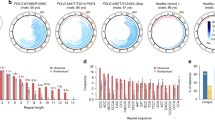Abstract
The cause of the high variability of human mitochondrial DNA (mtDNA) remains largely unknown. Three mechanisms of mutagenesis that might account for the generation of nucleotide substitutions in mtDNA have been analyzed: deamination of DNA nitrous bases caused by deamination agents, tautomeric proton migration in nitrous bases, and the hydrolysis of the glycoside bond between the nitrous base and carbohydrate residue in nucleotides against the background of the free-radical damage of DNA polymerase γ. Quantum chemical calculations demonstrated that the hydrolysis of the N-glycoside bond is the most probable mechanism; it is especially prominent in the H strand, which remains free during mtDNA replication for a relatively long time. It has also been found that hydrolytic deamination of adenine in single-stranded regions of the H strand is a possible cause of the high frequency of T → C transitions in the mutation spectra of the L-chain of the major mtDNA noncoding region.
Similar content being viewed by others
REFERENCES
Wallace D.C. 1999. Mitochondrial diseases in man and mouse. Science. 283, 1482–1488.
Budowle B., Wilson M.R., DiZinno J.A., Stauffer C., et al. 1999. Mitochondrial DNA regions HV I and HV II population data. Forensic Sci. Int. 103, 23–35.
Malyarchuk B.A., Rogozin I.B. 2004. Mutagenesis by transient misalignment in human mitochondrial DNA control region. Ann. Hum. Genet. 68, 324–339.
Marcelino L.A., Thilly W.G. 1999. Mitochondrial mutagenesis in human cells and tissues. Mutat. Res. 434, 177–203.
Gaeva E.B., Narezhnaya E.V., Kornienko I.V. 2004. Determining mutagenic activity using an example of interaction between DNA bases and nitrous acid. Klin. Lab. Diagn. 1, 16–18.
Clark T. 1990. Computer Chemistry (Russian translation). Moscow: Mir.
Stewart J.J.P. 1989. Optimization of parameters for semiempirical methods: 1. Method. J. Comput. Chem. 10, 209.
Stewart J.J.P. 1989. Optimization of parameters for semiempirical methods: 2. Applications. J. Comput. Chem. 10, 221.
Schmidt M., Baldridge K.K., Boatz J.A., et al. 1993. J. Comput. Chem. 14, 1347 (package of ab initio programs GAMESS, Version 5.0, 1998).
Tanaka M., Ozawa T. 1994. Strand asymmetry in human mitochondrial DNA mutations. Genomics. 22, 327–335.
Brown W.M., George M., Wilson A.C. 1979. Rapid evolution of animal mitochondrial DNA. Proc. Natl. Acad. Sci. USA. 76, 1967–1971.
Strack H.B., Freese E.B., Freese E. 1964. Comparison of mutation and inactivation rates induced in bacteriophage and transforming DNA by various mutagens. Mutat. Res. 1, 10–21.
Soyfer V.N. 1969. Molekulyarnye mekhanizmy mutageneza (Molecular Mechanisms of Mutagenesis). Moscow: Nauka.
Ashmarin I.P. 1974. Molekulyarnaya biologiya (Molecular Biology). Leningrad: Meditsina, pp. 186–191.
Kochetkov N.K., Budovskii E.I., Sverdlov E.D., et al. 1970. Organicheskaya khimiya nukleinovykh kislot (Organic Chemistry of Nucleic Acids). Moscow: Khimiya.
Lindahl T. 1993. Instability and decay of the primary structure of DNA. Nature. 362, 709–715.
Krishnan N.M., Raina S.Z., Pollock D.D. 2004. Analysis of among-site variation in substitution patterns. Biol. Proced. Online. 6, 180–188.
Roberts J., Casserio M. 1978. Fundamentals of Organic Chemistry [Russian translation]. Moscow: Mir, vol. 2.
Cantor C.R., Schimmel P.R. 1980. Biophysical Chemistry. San Francisco: W. H. Freeman.
Watson J.D., Baker T.A., Bell S.P., Gann A., Levine M., Losick R. 2004. Molecular Biology of the Gene. Cold Spring Harbor, N.Y.: Cold Spring Harbor Lab. Press.
Ladik J. 1975. Quantum Biochemistry for Chemists and Biologists [Russian translation]. Moscow: Mir.
Brown T.A. 1994. DNA Sequencing. Oxford: IRL Press.
Graziewicz M.A., Day B.J., Copeland W.C. 2002. The mitochondrial DNA polymerase as a target of oxidative damage. Nucleic Acids Res. 30, 2817–2824.
Clayton D.A. 1991. Replication and transcription of vertebrate mitochondrial DNA. Annu. Rev. Cell Biol. 7, 453–478.
Freese E.B. 1961. Transitions and transversions induced by depurination agents. Proc. Natl. Acad. Sci. USA. 47, 540–545.
Author information
Authors and Affiliations
Additional information
__________
Translated from Molekulyarnaya Biologiya, Vol. 39, No. 5, 2005, pp. 869–877.
Original Russian Text Copyright © 2005 by Kornienko, Malyarchuk.
Rights and permissions
About this article
Cite this article
Kornienko, I.V., Malyarchuk, B.A. Analysis of Mutation Mechanisms in Human Mitochondrial DNA. Mol Biol 39, 761–768 (2005). https://doi.org/10.1007/s11008-005-0091-z
Received:
Issue Date:
DOI: https://doi.org/10.1007/s11008-005-0091-z




